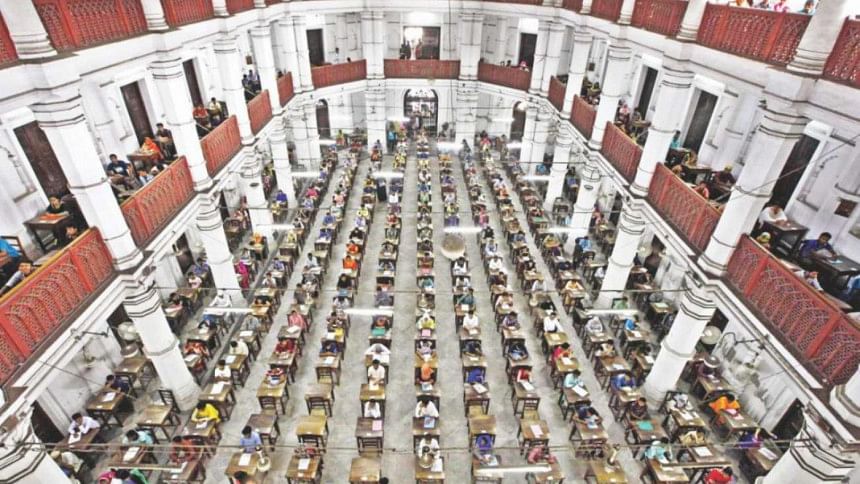Why a unified system is necessary in Bangladesh

University admission procedures vary from country to country, and sometimes from institution to institution in a country. In many countries, prospective university students apply for admission during their last year of higher secondary school or community college. In some countries, there are independent organisations or government agencies responsible for organising centralised admission tests and the processing of applications.
Before we discuss the situation in Bangladesh, let us take a look at the various admission tests in various countries. Australia, for example, has centralised processing units for admission to undergraduate degrees for the high school graduates of Australia and New Zealand. In order to enter university in Brazil, candidates must undergo a central public examination called "Vestibular," which lasts about one week and takes place once a year. They have created a unified, national university application system known as SISU for all kinds of admission in the university level education.
In the People's Republic of China, high school leavers are required to sit for the two-day National College Entrance Exam (Gaokao), the results of which determine which university they can attend.
In India, university admission tests are organised by an independent body. Preference is given more to a student's performance in the tests than their past academic record. The applicants are ranked by their exam grades, and they can choose universities/programmes based on their grades. Among such entrance tests are the Joint Entrance Exam, Common Admission Test (CAT), etc.
Germany, Greece, Hong Kong, Indonesia, Japan and some other countries have centralised admission tests for the enrolment of students into universities.
In Turkey, there is a highly competitive, centralised university admission system. Every higher secondary school leaver is entitled to sit for the standardised university entrance exam in June, which is organised by the Student Selection and Placement Centres under the Ministry of Education. A point system is used to control access to each course. Students have to submit a list of up to ten of their preferred institutions or universities, and these are taken into account when universities work out course requirements after the exam results have been published.
In the United States, there is no single, nationwide university admission system. But there are a number of post-secondary admission tests used by its 3,000 institutions, including the Scholastic Assessment Test. The SAT is a three-hour, non-academic exam intended to measure basic skills. At the time of admission, most universities look for the students' SAT scores in addition to higher secondary school certificates.
Students must also list their academic qualifications and extracurricular interests in their curricula vitae. Universities charge a fee of up to USD 50 for each individual application. Application forms are usually available a year in advance and closing dates differ from university to university. As there is no central administration body, students send their application forms to the institution itself. Students are notified of their acceptance between April and June and take up their places in autumn.
In many developing countries, university admission systems use a common point method administered by the University Grants Commissions. Students submit a list of up to 20 course choices to the Central Applications Office (CAO) by the beginning of February each year. They can choose ten degree courses and/or ten diploma/certificate courses. Students are urged to list them in order of their own preference.
Any student with an HSC or equivalent certificate is entitled to apply for the test. Admission tests are almost entirely based on the curricula set by the central admission agency like the University Grants Commission in Bangladesh.
Critics of the system, however, complain that because computers match students to courses on the basis of their total score, aspects such as a student's personality are not taken into consideration, which can cause difficulties in case of people-based subjects.
In many countries, universities make their first round of offers just days after the exam results of the central admission tests are published and the second round of offers come sometime later to fill up any vacancies left. Applicants are entitled to a place on the highest preferences that tally with their exam score.
Italy prides itself on its long-established principle of "free access" for every school leaver to all degree courses. Any Italian student with a school leaving certificate has the right to enrol for any degree course at any state university. This system has worked because the supply of students does not exceed the demand for students for enrolment.
But in some developing countries, including Bangladesh, the scenario is completely different as the number of students seeking admission is much higher than the number of seats available.
Unlike Europe, it is not possible in Bangladesh to create a system in which students with a science background can automatically qualify for entry to an arts course, because of our school curricula. However, it is entirely possible to introduce a Combined University Admission Test under the University Grants Commission which will reduce the time it takes a student to prepare and sit for admission tests, and minimise their costs and sufferings.
Courses that lead directly to professional qualifications, such as engineering and medicine, may be targeted first for arranging separate combined admission tests, and then gradually, general universities may also be brought into a centralised admission test system. All we need to understand is why many countries have gone for such systems, which, if adopted in Bangladesh, will obviously ease the sufferings of millions of admission seekers across the country.
I think the authorities of our education sector need to consider this option. The good thing is, it will not require huge investment on the part of the government. That said, caution must also be exercised so that question papers for the centralised admission tests are not leaked.
Md Shamsul Arefin is Director General, Anti-Corruption Commission.





Comments